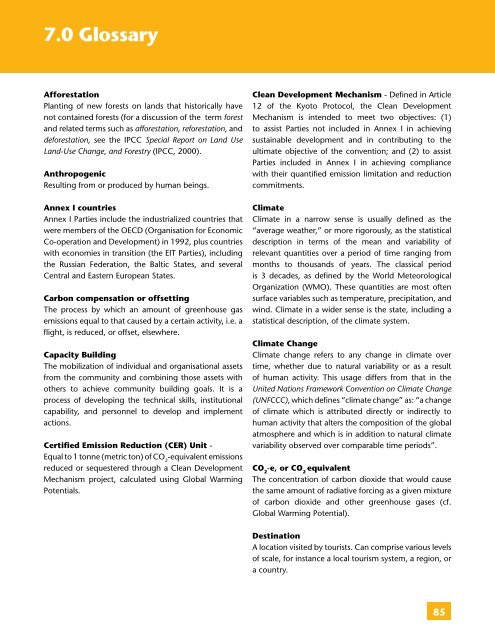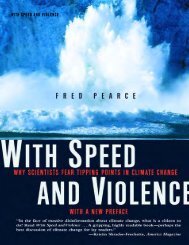Tourism & CC Challenges & Opportunities - Global Commons Institute
Tourism & CC Challenges & Opportunities - Global Commons Institute
Tourism & CC Challenges & Opportunities - Global Commons Institute
You also want an ePaper? Increase the reach of your titles
YUMPU automatically turns print PDFs into web optimized ePapers that Google loves.
7.0 Glossary<br />
Glossary<br />
Afforestation<br />
Planting of new forests on lands that historically have<br />
not contained forests (for a discussion of the term forest<br />
and related terms such as afforestation, reforestation, and<br />
deforestation, see the IP<strong>CC</strong> Special Report on Land Use<br />
Land-Use Change, and Forestry (IP<strong>CC</strong>, 2000).<br />
Anthropogenic<br />
Resulting from or produced by human beings.<br />
Annex I countries<br />
Annex I Parties include the industrialized countries that<br />
were members of the OECD (Organisation for Economic<br />
Co-operation and Development) in 1992, plus countries<br />
with economies in transition (the EIT Parties), including<br />
the Russian Federation, the Baltic States, and several<br />
Central and Eastern European States.<br />
Carbon compensation or offsetting<br />
The process by which an amount of greenhouse gas<br />
emissions equal to that caused by a certain activity, i.e. a<br />
flight, is reduced, or offset, elsewhere.<br />
Capacity Building<br />
The mobilization of individual and organisational assets<br />
from the community and combining those assets with<br />
others to achieve community building goals. It is a<br />
process of developing the technical skills, institutional<br />
capability, and personnel to develop and implement<br />
actions.<br />
Certified Emission Reduction (CER) Unit -<br />
Equal to 1 tonne (metric ton) of CO 2<br />
-equivalent emissions<br />
reduced or sequestered through a Clean Development<br />
Mechanism project, calculated using <strong>Global</strong> Warming<br />
Potentials.<br />
Clean Development Mechanism - Defined in Article<br />
12 of the Kyoto Protocol, the Clean Development<br />
Mechanism is intended to meet two objectives: (1)<br />
to assist Parties not included in Annex I in achieving<br />
sustainable development and in contributing to the<br />
ultimate objective of the convention; and (2) to assist<br />
Parties included in Annex I in achieving compliance<br />
with their quantified emission limitation and reduction<br />
commitments.<br />
Climate<br />
Climate in a narrow sense is usually defined as the<br />
“average weather,” or more rigorously, as the statistical<br />
description in terms of the mean and variability of<br />
relevant quantities over a period of time ranging from<br />
months to thousands of years. The classical period<br />
is 3 decades, as defined by the World Meteorological<br />
Organization (WMO). These quantities are most often<br />
surface variables such as temperature, precipitation, and<br />
wind. Climate in a wider sense is the state, including a<br />
statistical description, of the climate system.<br />
Climate Change<br />
Climate change refers to any change in climate over<br />
time, whether due to natural variability or as a result<br />
of human activity. This usage differs from that in the<br />
United Nations Framework Convention on Climate Change<br />
(UNF<strong>CC</strong>C), which defines “climate change” as: “a change<br />
of climate which is attributed directly or indirectly to<br />
human activity that alters the composition of the global<br />
atmosphere and which is in addition to natural climate<br />
variability observed over comparable time periods”.<br />
CO 2<br />
-e, or CO 2<br />
equivalent<br />
The concentration of carbon dioxide that would cause<br />
the same amount of radiative forcing as a given mixture<br />
of carbon dioxide and other greenhouse gases (cf.<br />
<strong>Global</strong> Warming Potential).<br />
Destination<br />
A location visited by tourists. Can comprise various levels<br />
of scale, for instance a local tourism system, a region, or<br />
a country.<br />
85
















